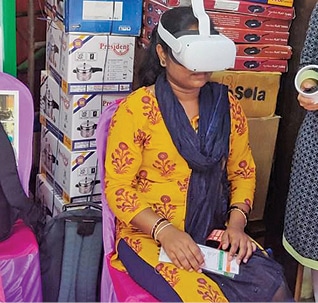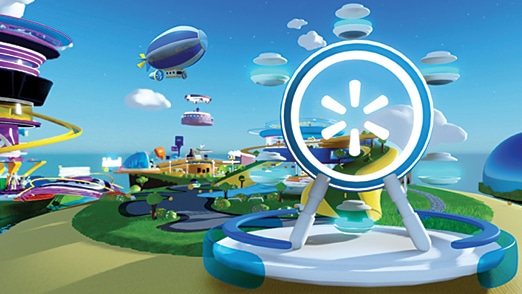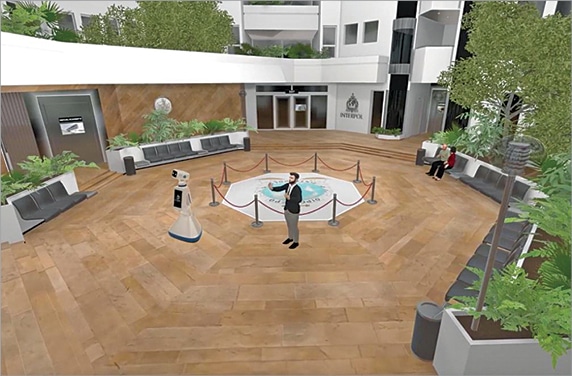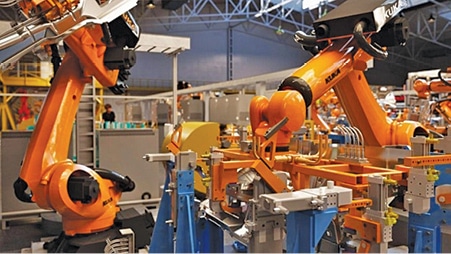What do INTERPOL, Flipkart, Union Bank of India, and Virat Kohli have in common?
They all entered the metaverse in the past quarter.
Virtual reality (VR) gear is still too expensive for most people. Technically, you can enter the metaverse without it using a normal web browser. But, sadly, it feels like a badly designed video game without the proper gear!
Facebook, which betted big on the metaverse and even changed the name of the company to Meta to reflect its commitment to the concept, is not doing so well. And industry-watchers are suggesting the company should start focusing on other things, and even change the name again. What’s more, Apple CEO Tim Cook thinks the metaverse is too bizarre a concept for common folks to understand and meaningfully incorporate into their daily lives.
Yet, none of this seems to discourage people—especially companies—from setting foot in the metaverse. Some early movers feel there will be tangible gains in the near future, while some are simply curious, and adventurous enough to explore and test the new waters. Others are driven mainly by the fear of missing out.
Whatever be the motive, there is undoubtedly a lot happening in this emerging new world called the metaverse. Therefore, we continue to bring you our quarterly update.

E-tailers wooing customers in the metaverse
All major e-commerce brands have been experimenting with the metaverse in the past few months. As part of its Great Indian Festival, Amazon brought its Metaworld experience to a few Indian cities, including Bengaluru, Hyderabad, Kanpur, and Nagpur. This was an expo kind of setup, replete with actual physical events like concerts and games.
The highlight, however, was the kiosks that visitors could use to experience the virtual Metaworld. Here their avatars could browse through their favourite Amazon categories, as well as play against each other to win offers and deals.
In October, Flipkart also trialled its Flipverse on the Polygon platform. Several well-known brands, including Puma and Noise, participated in the week-long pilot run. Touted to be the company’s entry into Web3, and as the beginning of E-commerce 2.0, Flipverse gives users an AAA gaming environment (a high-profile, high-budget, high-performance gaming experience, informally expanded as a lot of money, a lot of resources, and a lot of time) where their digital avatars can discover products, unlock special offers, and purchase unique collectibles.
The company aims to enter the next level of consumer engagement and retention through Flipverse by creating a bi-directional bond between users and their favourite brands. Flipverse apparently features a very photorealistic visual space, and also lets users build photorealistic digital avatars from selfies.
According to a Polygon blog, “The crown jewel in the Flipverse is eDAO’s The Strand, a free collectible that opens access to intellectual properties (IPs), brands, and culture. The Strand gives users a tangible connection to their beloved icons, artists, and brands. It is a promise that you will always be a citizen of the culture multiverse. Over 75,000 have been activated to date.”
In September, Walmart launched Walmart Land and Walmart’s Universe of Play on the popular metaverse platform Roblox. Basically, digital avatars can move through the space and collect coins strewn around, or play games to earn them and spend them at a virtual store to buy virtual merchandise—termed as ‘verch’—for their digital avatars. Well, sounds like just another virtual reality game (creating the fear of missing out).
Speaking at the Yahoo Finance All Markets Summit in October this year, Suresh Kumar, the global CTO of Walmart, remarked that the way customers are getting inspired and are discovering products is changing. Hence, in the future, live broadcasting on the metaverse and marketing through social media platforms would be effective ways to reach a large segment of consumers.
He also predicted that Bitcoin might play a significant role in that environment’s payment system, adding that both physical and virtual goods would be purchased using crypto. Some of Walmart’s patent applications indicate that the company is working on creating digital currency, tokens, and non-fungible tokens (NFTs) for the metaverse.
Automakers and others too
Not just e-tailers, but even offline brands are dipping their feet in the metaverse. We caught up with the long list of automakers launching models on the metaverse in September’s metaverse round-up. This included names like Mahindra, Maruti Suzuki, MG Motor, and Hyundai.
More of them joined this quarter. TVS Motor Company, a leading two-wheeler manufacturer headquartered in Chennai, launched the TVS Raider with SmartXonnect technology on their metaverse platform, TVS Motoverse. According to the company, this is the first motorcycle to be launched on the metaverse.
In October, 1Verse and Tyremarket.com launched the world’s first fully-integrated metaverse based dealership to sell two- and three-wheel electric vehicles (EVs) throughout India. They have adopted a fusion model, which allows users to shop through local metaverse kiosks (basically local dealers equipped with VR gear), or through their own computers or mobile phones. Through a newly-formed subsidiary, Tyremarket.com provides sales expertise, local EV distribution, technology enhancements, and access to tens of millions of existing customers in India.
“1Verse features the capability to create metaverse EV storefronts, where brick and mortar sales infrastructure is limited. Instead of traveling 50 miles or more to an EV dealership, people will be able to access a physical location right near them, where they can look at, customise and even test drive the EV that they want to purchase,” says Prashanth Joshua, Co-founder and CEO of 1Verse.
Democratising the metaverse
Recently, Reliance Industries Limited (RIL) posted the proceedings of its second quarter earnings on the metaverse. This was done using GMetri, a platform on which you can create your metaverse within minutes without any coding at all. The metaverse content included over an hour of results summary and commentary by the top management, as well as several slides, graphics, transcripts, and quotes that analysts could view and download. It could be accessed using any device, even smartphones and laptops, without the need for any VR or augmented reality (AR) gear.
GMetriXR is a no-code toolkit to create, manage, and track your own metaverse. It is replete with a large number of ready-to-go media assets and gamified features, which you can put together to create an immersive environment. The company is aiming to democratise the metaverse, so anyone can create their own space without any prior experience or coding skills.

Democratisation seems to be a prominent theme today. Shriram Group’s Novac Technologies was speaking on similar lines when they showcased their tools at the Gulf Information Technology Exhibition (Gitex) in Dubai this October. Novac believes that Indian companies are more comfortable having their own metaverse domain rather than having to buy land in decentralised ones like Decentraland or The Sandbox, and they help them with this requirement. They have over 50 clients in the manufacturing space. For most, they have helped create digital twins replicating the physical models in their factories for training across departments, including operations, human resources, and administration. They have also developed several immersive soft skills training courses in association with a European company called Bodyswaps.
In a media report, Pradeep B., Associate Vice President, Novac, remarked that financial services companies are also now interested in tapping into the potential of the metaverse for branding and product development. “For instance, banks are likely to have digital avatars of real bank executives alongside existing AI-powered chatbots to help customers during and after office hours,” he said.
On the same lines of democratisation, digital entertainment and technology company JetSynthesys announced in September that it has acquired a major stake in Metaphy Labs to offer metaverse-as-a-service (MAAS) to brands desirous of building their own metaverses, with immersive user experiences and meta-commerce as well. JetSynthesys is backed by famous investors like Kris Gopalakrishnan, Adar Poonawalla, and Sachin Tendulkar.
NVIDIA has also fashioned a neat MAAS offering, especially suited for manufacturing industries. NVIDIA CEO Jensen Huang explained in a recent media report that, “When you say ‘metaverse,’ they imagine putting on VR headsets, but it’s obviously not just that. You can do that, but you can also enjoy it in 2D. One of my favourite ways of enjoying the metaverse is a whole bunch of robots in the metaverse doing work and communicating with robots that are outside in the physical world. The physical world and the metaverse can be connected in a lot of different ways. It doesn’t just have to be humans. It can be machine to machine.”
As part of Omniverse Cloud—a suite of cloud services for metaverse applications—NVIDIA is rolling out simulations for developing, testing, and managing artificial intelligence based robots and autonomous vehicles. Omniverse’s 3D collaborative tools run on NVIDIA’s well-known chips and hardware, including NVIDIA OVX—a computing system specifically designed to power large-scale digital twin simulations, which replicate real-world spaces in a metaverse environment.
Banks too have started banking on meta
After the pandemic, which proved that online services are indispensable, banks and other financial institutions are looking at the metaverse as one more way to stay in touch with customers. The first bank to enter the metaverse was perhaps JP Morgan, which opened a lounge called Onyx on Decentraland in February this year to engage with next-gen users. Subsequently, HSBC also opened a similar lounge on The Sandbox.
In July this year, Union Bank of India launched its metaverse virtual lounge, the Uni-verse, in association with Tech Mahindra. Users can roam around the lounge and get information about bank deposits, loans, government welfare schemes, and so on. The bank plans to use the lounge to publicise its products, but does not intend to enable transactions on it in the near future.
Recently, Kiya.ai, a Mumbai based fintech company, launched Kiyaverse—supposedly India’s first banking metaverse. Banks as well as non-banking finance companies (NBFCs) can use the platform to create their own in-branch experiences on the metaverse. Users can access the platform through multiple interfaces, including digital banking units, mobiles, laptops, VR headsets, and mixed reality (MR) environments. Through their virtual avatars, users can interact with a virtual relationship manager, and avail basic and value-added services like portfolio analysis, wealth management, co-lending, and corporate banking.
Kiya.ai will also offer various analytics based services to its partner banks and NBFCs. Future phases are likely to support central bank digital currencies (CBDCs) for transactions and interoperability with other metaverses. Open application programming interface (API) connectors with aggregators and gateways will eventually enable a banking super-app and marketplace.
They hope to give users a near real-world interaction experience with haptics-enabled headsets and using the ‘Internet of Senses.’ The Internet of Senses is a concept floated last year by Ericsson as part of its vision for 2030. It proposes the idea of a full sensory immersion in cyberspace, made possible by the low latency and high bandwidth of 5G.
The new-age collectibles
Movies and cricket are two undying passions in India. Digital collectibles, that is NFTs, are likely to do well in both these fields.
A couple of months back, Singapore based Vistas Media Capital partnered with Rocketry – The Nambi Effect to introduce NFTs themed around the movie plot and scientific research on their metaverse space called the VistaVerse. It was a runaway success, with more than 10,000 NFTs being claimed.
Zee Entertainment Enterprises, the well-known media house, opened its Tech & Innovation centre in Bengaluru a couple of months ago. Among other things, the centre will focus on Zee’s metaverse, the Zeeverse, which will offer numerous interesting NFTs from the movies, music, and shows that the company holds the license to. According to the company, viewers will also be able to meet their favourite stars through the Zeeverse.

Earlier this year, T-Series announced a partnership with Hefty Entertainment, a division of Hungama Digital Media, to drop NFTs that leverage its mega content library.
In October, cricketer Virat Kohli tweeted that he was super pumped to enter the metaverse exclusively with FanCraze. This means, his fans can now buy digital collectibles, such as the digital version of a signed bat or poster, or a valuable cricketing moment, directly licensed from Kohli, and display them on their social media handles, trade them, and use them in various games.
Kohli joins a long list of Indian cricketers, including Rohit Sharma, Hardik Pandya, Suryakumar Yadav, Ravindra Jadeja, Shikhar Dhawan, Ravichandran Ashwin, Yuzvendra Chahal, and Shreyas Iyer, who have also partnered with FanCraze to drop digital collectibles and build a direct connect with their fans. “We view marquee athletes as artists who create their art on the field of play,” said FanCraze CEO Anshum Bhambri, in a media report.
It does not stop with buying NFTs but leads to more ways of engagement. For example, fans may be able to get on a Zoom call with a player whose collectibles they own, go to a nets session with them, interview them, or have access to signed merchandise.
A new crime scene for INTERPOL
At the 90th INTERPOL General Assembly held in New Delhi in October, the global police organisation unveiled its new metaverse, designed specifically for law enforcement. Registered users can tour a virtual replica of INTERPOL’s headquarters, interact with other officers via their avatars, and even take immersive training courses. During the demo, experts delivered a training on travel document verification and passenger screening using INTERPOL capabilities in a metaverse classroom. Students were then teleported to an airport where they were able to practically try out these skills at a virtual border point.
Law enforcers from around the world will benefit greatly from this metaverse in terms of remote work, networking, collaboration, collecting, and preserving evidence from crime scenes, and training in specific skills like forensic investigation. However, skilling up is not the only motive behind launching the metaverse. INTERPOL also wants law enforcers to better understand metaverse dynamics so they can prevent or address crimes therein.
The INTERPOL also announced the creation of an expert group on the metaverse, “to represent the concerns of law enforcement on the global stage—ensuring this new virtual world is secure by design.”
According to a Gartner report, by 2026, one in every four people will spend at least an hour a day in the metaverse to work, study, shop, and socialise. On the other hand, the newly released INTERPOL Global Crime Trend report shows that crime has increasingly moved online. The World Economic Forum has also warned of social engineering scams, violent extremism, and misinformation on the metaverse.
As the metaverse grows, we are likely to see crimes against children, data theft, money laundering, financial fraud, counterfeiting, ransomware, phishing, and sexual assault and harassment. These will present significant challenges for law enforcement. Hence, this pre-emptive step by INTERPOL to experience and understand the metaverse is extremely noteworthy.
“By identifying these risks from the outset, we can work with stakeholders to shape the necessary governance frameworks and cut off future criminal markets before they are fully formed,” says Madan Oberoi, INTERPOL’s Executive Director of Technology and Innovation. “Only by having these conversations now can we build an effective response.”
Diwali pujas and wellness gyaan
This Diwali, Totality Corp organised Lakshmi Puja on the Zionverse, its metaverse that is based on Indian culture and mythology! Zionverse offered users a choice of private or public rooms to experience the puja. Users could invite their family and friends to their private room through a QR code. In the public room, users celebrated with the rest of the community.
Speaking of spirituality and well-being, personal transformation coach Deepak Chopra announced the launch of the ChopraVerse, a collaboration between Seva.Love—a metaverse for wellbeing initiative, and Utopia—an emerging Web3 ecosystem. Deepak Chopra’s home in the metaverse, The House of Enlightenment, has been designed by Vera Iconica Architecture.

As part of the initial launch, users can experience the house on the metaverse and purchase downloadable blueprints as NFTs. This is something interesting, because the design, which incorporates elements of eastern wisdom and design principles for wellness, can be replicated in the physical world using these blueprints. ChopraVerse will also feature gamified content for kids, to play and learn the secrets of wellness early in life.
Speaking to CoinDesk TV’s First Mover in October, Deepak Chopra remarked that tech giants need better motivation for moving into the metaverse than just making money, if they want to make a true impact and avoid the fate of the dinosaurs!
| More nuggets of meta news |
|
AR, meta, mobiles, who will win the race?
Despite so many people trying to set foot in the metaverse, many global thought leaders and industry majors have radically different views about it. At the WSJ Live Conference in October, Evan Spiegel, Founder of Snap Inc. argued that the future of computing is not the metaverse, and that most people would prefer augmented reality, which lets people harness computing power without forcing them to rely on a single screen. “The metaverse is ‘living inside of a computer.’ The last thing I want to do when I get home from work during a long day is live inside of a computer,” Spiegel says.
At the same event, Greg Joswiak, Senior Vice President of Worldwide Marketing at Apple Inc., is said to have commented that the metaverse is a word he would never use! And Phil Spencer, Head of Xbox at Microsoft, called the metaverse a “poorly built video game.”

In a recent interview with Bright, a Dutch media house, CEO Tim Cook explained why Apple is still hesitant to join the metaverse hype. He said, “I always think it’s important that people understand what something is. And I’m really not sure the average person can tell you what the metaverse is.”
He instead bets on AR becoming the next big trend in computing. From teaching to medicine, there are many fields that it will revolutionise, and it is likely to be to the next generation what the internet is to us. “I think AR is a profound technology that will affect everything. Imagine suddenly being able to teach with AR and demonstrate things that way. Or medically, and so on. Like I said, we are really going to look back and think about how we once lived without AR,” he remarked.
Nokia, on the other hand, seems to have a positive prediction for the metaverse. As reported by The Spokesman-Review, Nokia’s Chief Strategy and Technology Officer Nishant Batra shared their belief that the mobile phone will be overtaken by a metaverse experience in the second half of the decade. “Widespread adoption of the technology from both corporations and consumers will be critical for it to really take off, and this will also depend on the availability of affordable, ergonomic wirelessly connected VR and AR devices,” he added.
In the meanwhile, Meta, the name that comes to mind as soon as you think about the metaverse, is in dire straits. The company’s market value has plummeted pathetically this year. With the steady drop in share prices, Mark Zuckerberg has already lost around 61% of his wealth since the start of 2022, according to the Bloomberg Billionaires Index. This has pulled him down from being the third richest person in the world to twenty-third.
In Time to Get Fit—an Open Letter from Altimeter to Mark Zuckerberg (and the Meta Board of Directors), Brad Gerstner, CEO of Altimeter Capital and Meta shareholder, wrote, “Meta has drifted into the land of excess—too many people, too many ideas, too little urgency. This lack of focus and fitness is obscured when growth is easy but deadly when growth slows and technology changes.” To get its mojo back, Gerstner says Meta needs to get fit and focused. He recommends that they reduce headcount expense by at least 20%; reduce annual capex by at least $5 billion; and limit investment in metaverse/Reality Labs to no more than $5 billion per year.
Yet, Zuckerberg is not ready to give up. After posting a dismal third-quarter earnings statement, he is said to have defended the company saying, “I get that a lot of people might disagree with this investment but from what I can tell, I think this is going to be a very important thing… It’s some of the most historic work we’re doing that people will look back at over decades. Those who are patient and invest with us will end up being rewarded.”
A McKinsey report predicts that the metaverse will add $5 trillion to the value of the global economy by 2030. Thought leader Bernard Marr states in a Forbes report that, “There’s everything to play for, and 2023 is likely to be a key year for defining the direction it will take.”
The metaverse is likely to emerge as an effective marketing channel. Industries will warm up to the idea of using ‘digital twins’ to bring in operational efficiencies. VR and AR technologies are likely to improve. And all of these might give the metaverse a much-needed fillip. We will see you with more metaverse news and trends next year!
Janani G. Vikram is a freelance writer based in Chennai, who loves to write on emerging technologies and Indian culture. She believes in relishing every moment of life, as happy memories are the best savings for the future









